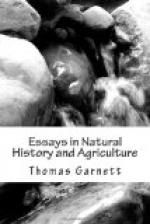* * * * *
ARTIFICIAL BREEDING OF FISH.
CLITHEROE, December 26th, 1853.
To the Editor of the “Manchester Guardian.”
SIR,—I have read with some interest the letter of your correspondent, Salmo Salar, on the artificial breeding of fish; and knowing, as I do, the great interest which the writer feels in the preservation and increase of his namesakes, I shall be most happy if my humble efforts in the same cause throw any more light on the same subject, and in any degree contribute to the same end.
But Mr. Salmo Salar is quite wrong in saying that, with the exceptions of the experiments made on the banks of the Hodder, by Ramsbottom, no efforts have been made to increase the number of Salmon by providing artificial breeding-places. Passing over my own numerous experiments here for the last fourteen or fifteen years (which you, Sir, are aware of, though the fishing world is not), I may refer to the extensive experiments made by Mr. Fawkes, of Farnley, in 1841 and 1842, and renewed again in 1848 and 1849; and the whole of which (with the exception of a portion of these in 1842) were successful. The experiments of Salmo Salar were not made until 1851 and 1852, and were intended merely to test the accuracy of an assumption that the impregnation of the ova takes place long prior to their exclusion; which experiments terminated in a complete failure. Salmo Salar says that the quantity of Salmon fry in the river is enormous; and that he has caught five pounds of them in a single pool in a single day. I have known three times that quantity caught in the same way. But still this proves nothing at all, for it is well known that almost all migratory animals, however solitary their general habits may be, are gregarious at the time of migration. Witness swallows, fieldfares, and even woodcocks. Witness also the clouds of small Eels ascending the rivers in May and June; and if we are to believe the accounts of travellers, the enormous flocks of antelopes in Africa, and of bisons in America, are proofs of the same general law. No doubt Salmo Salar will find, as he says, that the Samlets are exceedingly abundant in some of the pools, when they have flocked together for the purpose of migration; but he may perhaps travel for miles either up or down the river before he will find any more. It is notorious that, in the tributaries of the Hodder, they are walled in, in many places, for the purpose of detaining them, that unscrupulous anglers may get as many of them as possible before they go to the sea. Salmo Salar is in error also when he says that Ramsbottom deposited 40,000 in the ponds of Galway, of which 20,000 are expected to be fruitful. The fact is, that he deposited 40,000 in December, 1852, of which above 20,000 are now alive and in the ponds, varying from four to five inches long to two or three, notwithstanding that experiment was made under very unfavourable circumstances; for there was so much mud in the stream that supplied the spawning-boxes, that when Ramsbottom left Galway he was afraid all the ova would be choked by it.




